New perk! Get after it with local recommendations just for you. Discover nearby events, routes out your door, and hidden gems when you sign up for the Local Running Drop.
Triathlon is an endurance sport, plain and simple. So why should you consider strength training a necessary part of a triathlon workout? The short answer is that strength training makes muscles stronger, and stronger muscles can perform longer at higher intensities before they fatigue.
Say you have a really cool muscle car, but it came with a tiny four-cylinder engine, so it doesn’t go very fast or have much power. You take it to the repair shop, where the basic engine is replaced with a big, strong V8 engine. Now you can speed along as fast as you like and have plenty of power to pass slower cars. Your body is just like the muscle car. If you keep the same body but change the engine that moves it, so that it’s stronger and has more power, then your athletic performances will improve and you will be passing slower competitors. Strength training creates a more powerful engine than if you were to rely on endurance training alone.
RELATED: Strength Training for Triathletes
There is an old saying among track coaches that you can only run as fast as you can move your arms. This sounds odd, but the arms and legs do move together while you are running. The pumping of your arms acts as a counterbalance to your legs to help rotate your hips and torso. Ever try running with your arms down at your sides? You can’t move very fast, and it feels awkward.
Keeping your arms pumping takes muscle. The elbows are bent, which requires the biceps muscles to work, and the entire arm moves forward and back, requiring the shoulders, chest, and back muscles to work. And the up-and-down motion of running causes your shoulders to bounce, which must be stabilized by the surrounding muscles to prevent injury. Over long distances your upper body can become tired, so the more strength and muscular endurance it has, the better.
The upper-body muscles covered here include the biceps, which keep the elbows bent; the triceps, which extend the elbows and balance the biceps; the deltoids, which move the arms fore and aft; and the lats, trapezius, and rhomboids, which stabilize the shoulder movements.
Upper Body Weight Training for Runners
Targeting Problem Areas
Discover what areas your upper body strength program should concentrate on.
| Symptom | Cause | Solution |
| Your arms drop lower during long runs. | Biceps fatigue. | Add more biceps exercises and reps. |
| Your shoulders become tight or start to hurt. | Bouncing and fatiguing shoulders | Focus more on shoulder strength for running. |
Hammer Curl
Muscle Focus: biceps
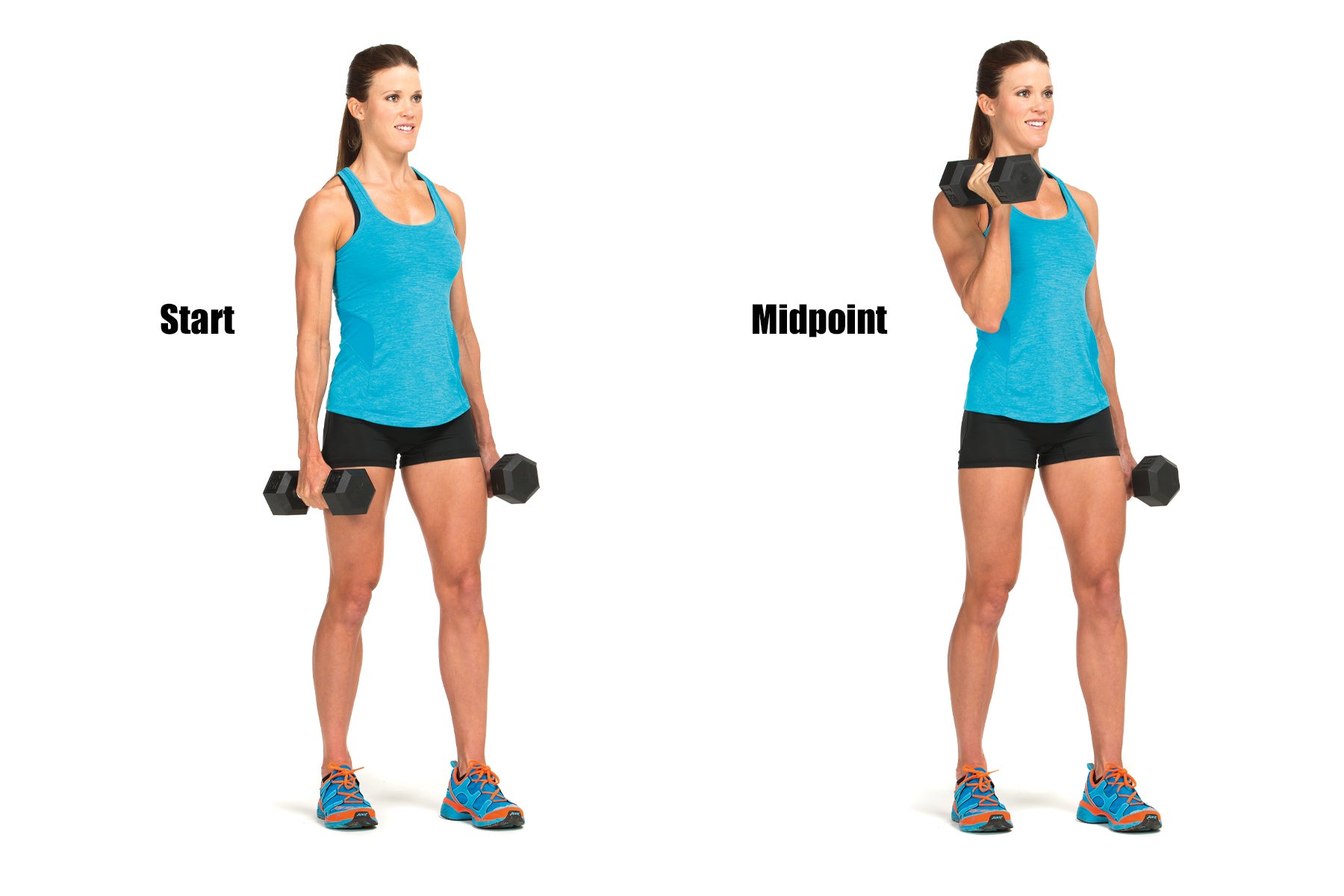
Photo: Jeff Nelson
The hammer curl is specific for running because it places the hand in a neutral position, just as it is while you are running and holding your elbows bent. The neutral hand position changes the emphasis of the exercise from the biceps brachii muscle to the brachioradialis muscle (both help bend the elbow), which is used more when you hold your arms in a bent position while running.
Stand with your feet shoulder width apart, one foot slightly in front of the other. Hold a dumbbell in each hand, arms straight and relaxed at your sides, palms facing your thighs (see start).
Keeping one arm at rest, with the other arm pull the dumbbell up to your shoulder by bending your elbow (see midpoint). Keep your elbow at your side when you lift the dumbbell; only your forearm and hand should be moving. Slowly let the dumbbell back down to the start position, completely straightening the arm, then repeat with the other arm. Alternate left and right curls until your set is complete.
Section dividerRunner’s Raise
Muscle Focus: biceps, delts
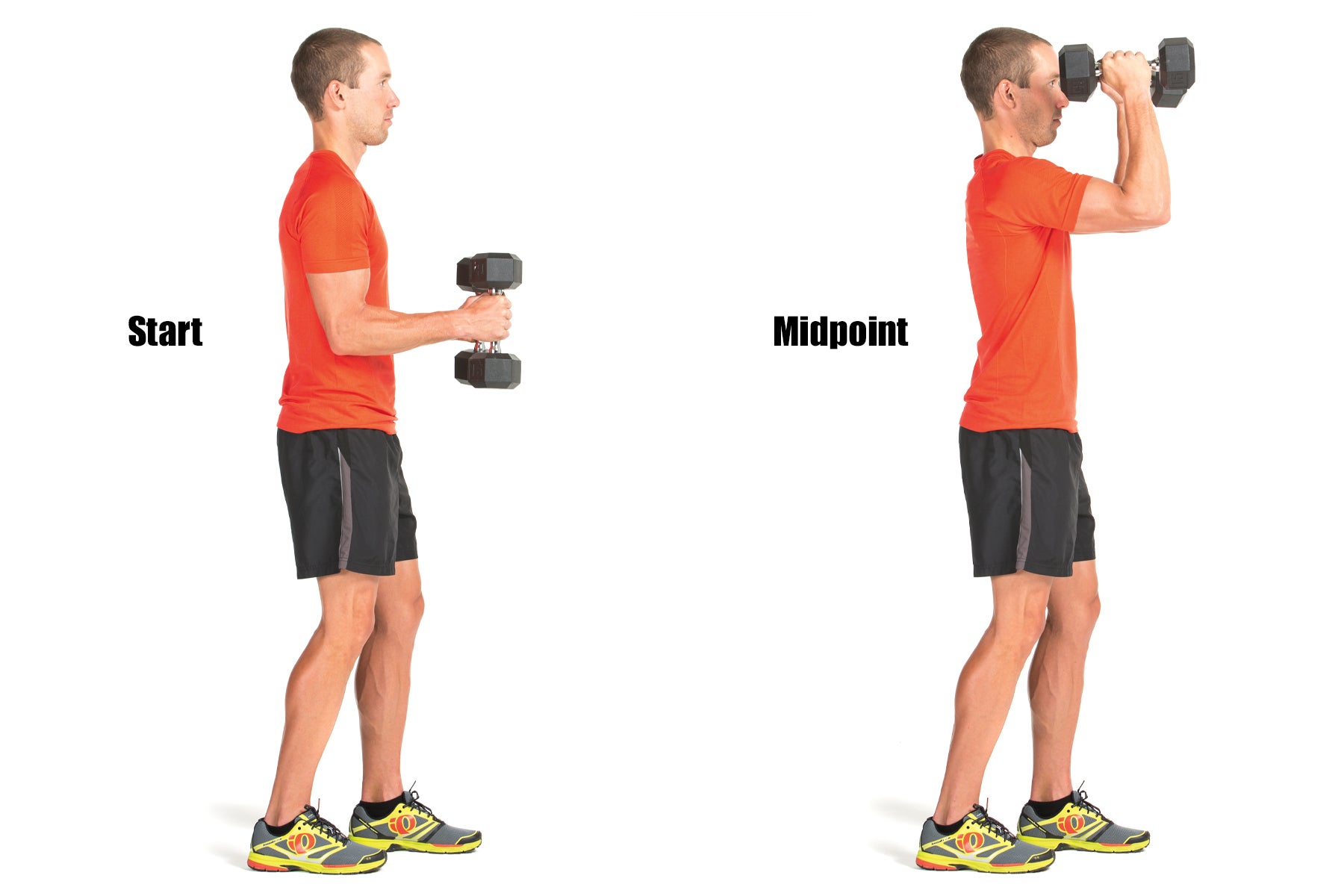
Photo: Jeff Nelson
The runner’s raise trains the biceps and the front part of the shoulder to keep your hands up by your sides during a long run. When you lack strength in these areas, you will notice that your arms slowly drop down as you run, reducing your efficiency.
Stand with your feet apart, one foot slightly in front of the other. Hold a dumbbell in each hand. Keeping your elbows at your sides, bend your arms to bring the dumbbells up in front of you until your arms are at a 90-degree angle (see start). (This is basically the halfway point of a hammer curl.)
Holding the 90-degree angle of your arms, lift your elbows forward and up until they are pointing straight out in front of you (see midpoint). The dumbbells will finish the movement near your head. Slowly lower your arms until your elbows come back to your sides (the dumbbells are still being held up in front of you), and repeat until your set is complete.
Section dividerUpright Row
Muscle Focus: biceps, delts, trapezius
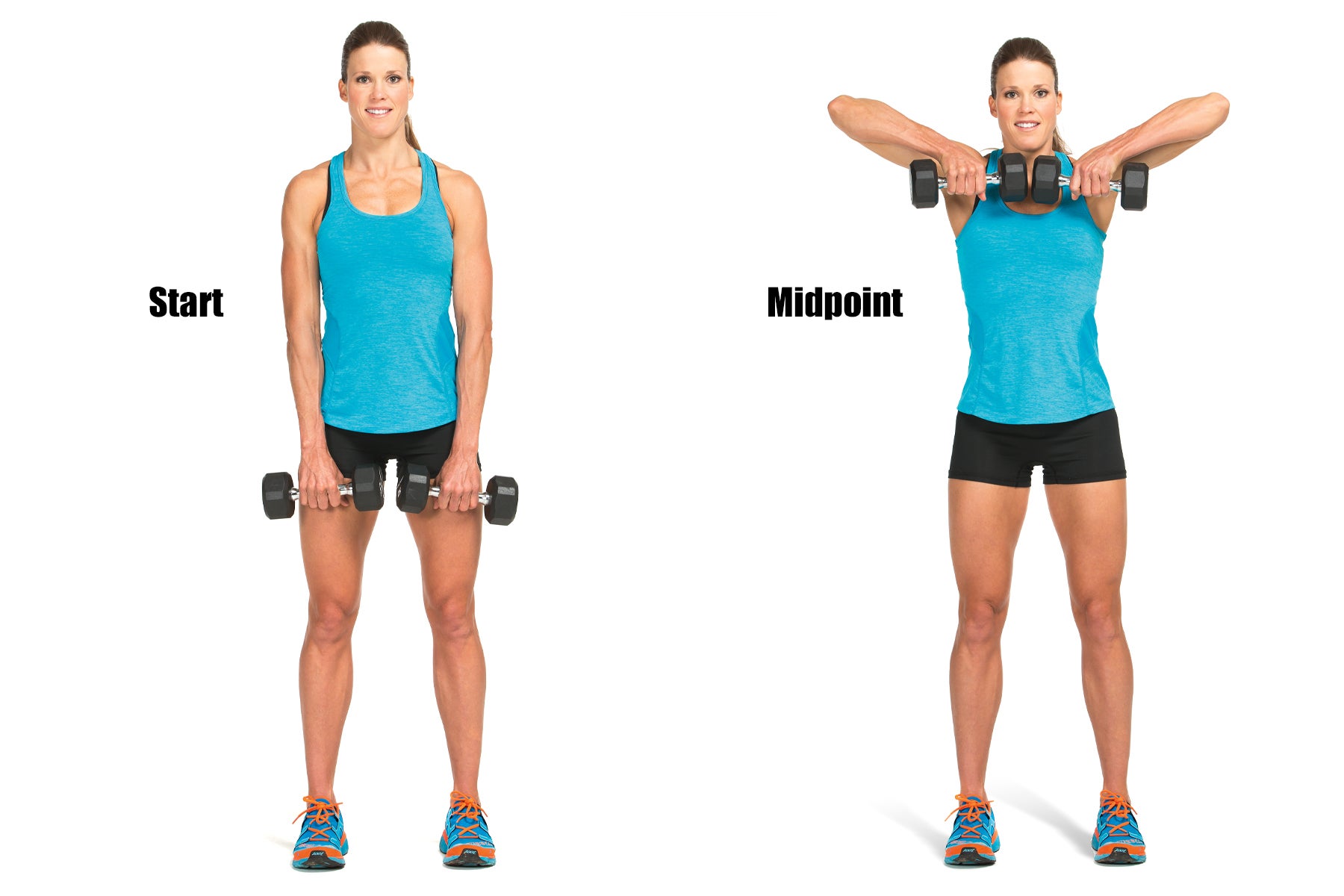
Photo: Jeff Nelson
The upright row assists in making the shoulders stronger (mainly the top of the shoulder), and with the trapezius prevents your shoulders from bouncing during your run, which can cause fatigue and injury.
Hold a dumbbell in each hand with your arms straight down in front of you and your palms facing your legs (see start). Stand with your feet shoulder width apart.
Pull the dumbbells up in a straight line, following the front of your torso until they reach your chin (see midpoint). Your elbows should end up pointed out to your sides or slightly upward. The key is to keep the dumbbells really close to your body and your elbows above your wrists at all times. If you pretend there are strings attached to your elbows that are being pulled from above, the motion will be very smooth. Slowly lower the dumbbells back down to the starting position and repeat until your set is complete.
Section dividerShrug
Muscle Focus: trapezius

Photo: Jeff Nelson
The shrug helps keep your shoulders high and able to hold the weight of your arms without bouncing.
Stand with your feet together. Hold a dumbbell in each hand with your palms facing your thighs and your arms hanging down straight at your sides. Let your shoulders sag, allowing the weight of the dumbbells to pull them down (see start).
Keeping your arms straight, lift your shoulders up toward your ears, effectively shrugging your shoulders (see midpoint). Do not move your shoulders forward or backward or rotate them in a circle—the movement is straight up and down. Slowly lower your shoulders back into the sagging start position and repeat the movement until your set is done.
Section dividerRetraction
Muscle Focus: delts, lats, trapezius, rhomboids

Photo: Jeff Nelson
If you have ever felt your upper back become fatigued during a run or found yourself needing to stretch your shoulders while running, this exercise will help. By working the back of the shoulder, retraction helps keep your torso upright and prevents slouching.
Attach your resistance tubing to the door anchor or wrap it around a pole a couple of feet off the floor. Sit down on the floor facing the anchor. Hold one handle in each hand with your arms straight out in front of you. Scoot back until the tubing is pulling you forward. Let your shoulders relax so that the tubing is pulling your shoulders forward and your back is rounded (see start).
Keeping your body still and your arms straight, pull your shoulders back while pushing your chest out (see midpoint). Attempt to squeeze your shoulder blades together, feeling the increased resistance on the tubing. This is a small movement but an important one for the trapezius muscle.
Section dividerTubing Row
Muscle Focus: biceps, delts, lats
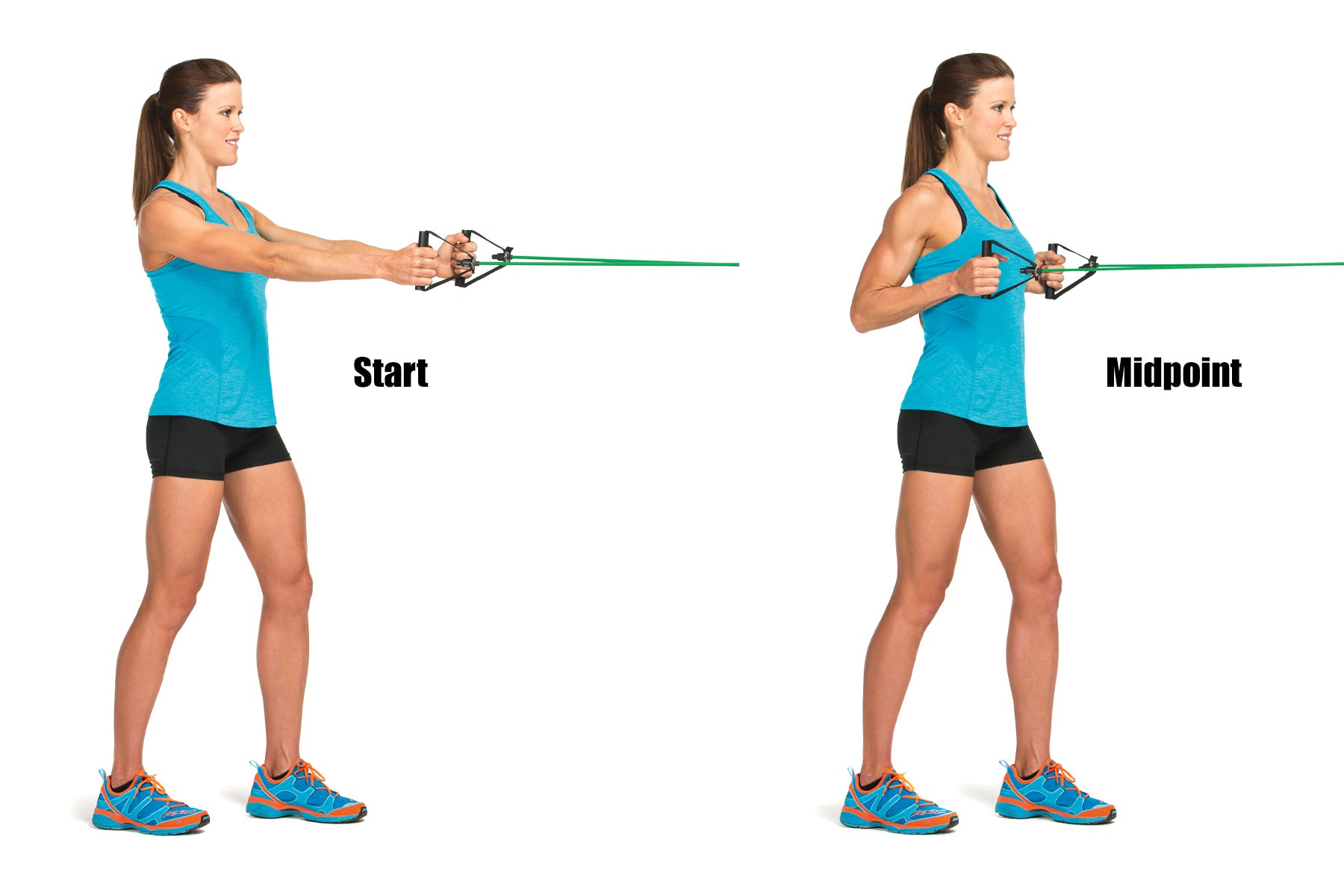
Photo: Jeff Nelson
If you have ever seen someone running with flailing arms, then you’ll understand why this exercise is important. The tubing row teaches you to pull your arms up tight against your body, improving efficiency and aerodynamics while also strengthening your shoulders (mainly the back of the shoulder) and back.
Attach your resistance tubing to the door anchor or wrap it around a pole at shoulder height. Hold one handle in each hand. Facing the anchor, hold your arms straight out in front of you, palms facing together and step back until the tubing is pulling you forward (see start). Stand with your feet apart and one foot slightly in front of the other to prevent you from being pulled forward. Keep your body upright and your back straight.
Pull back on the tubing with both hands, trying to bring your hands all the way to the sides of your body (see midpoint). In this position, your arms and hands should be in approximately the same position as they are when you run. Slowly let your arms back out until they are straight again. If there isn’t enough resistance, step back a little farther to make the tubing tighter. Repeat until your set is complete.
Section dividerBarbell Lift
Muscle Focus: biceps, delts
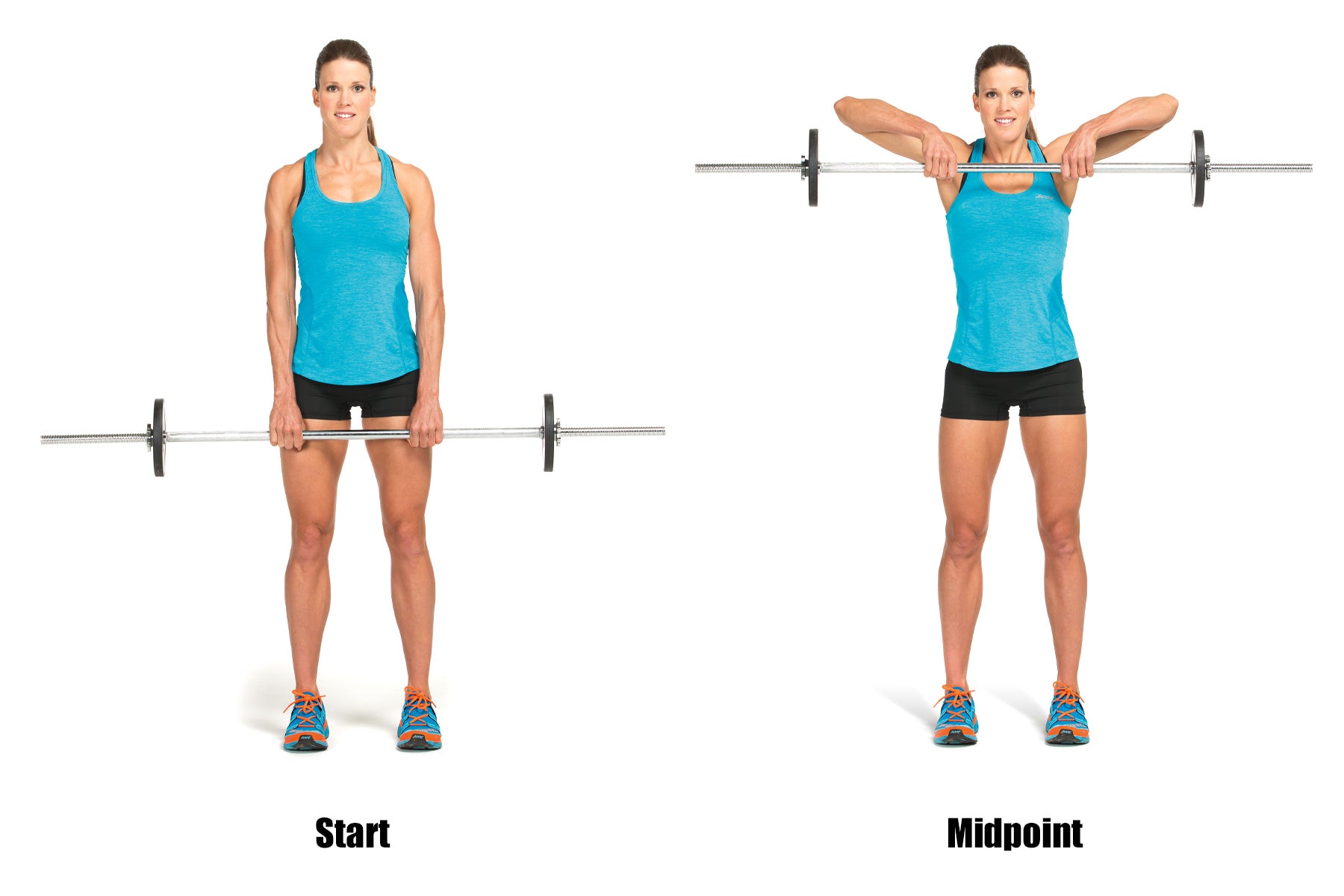
Photo: Jeff Nelson
The barbell lift trains your biceps and delts while necessitating an upright stance, such as you would have during a run. This exercise can’t be done hunched over, so it engages the delts to pull and maintain shoulder stability while the biceps are working—just as happens during a run.
Stand with your feet shoulder width apart. Hold a barbell against your thighs with an overhand grip, palms facing toward your legs. Your grip should be slightly narrower than shoulder width, with hands evenly spaced from the center (see start).
Keeping your elbows out to the sides, pull the bar up in front of your body until it’s directly under your chin (see midpoint). Throughout the lift, the bar should stay close to your body, while your elbows should be higher than your wrists, and your wrists should be higher than the bar. Slowly lower the bar back down the front of your body until your arms are completely straight again. Repeat until your set is complete.
Section dividerBarbell Row
Muscle Focus: biceps, delts, erector spinae, lats
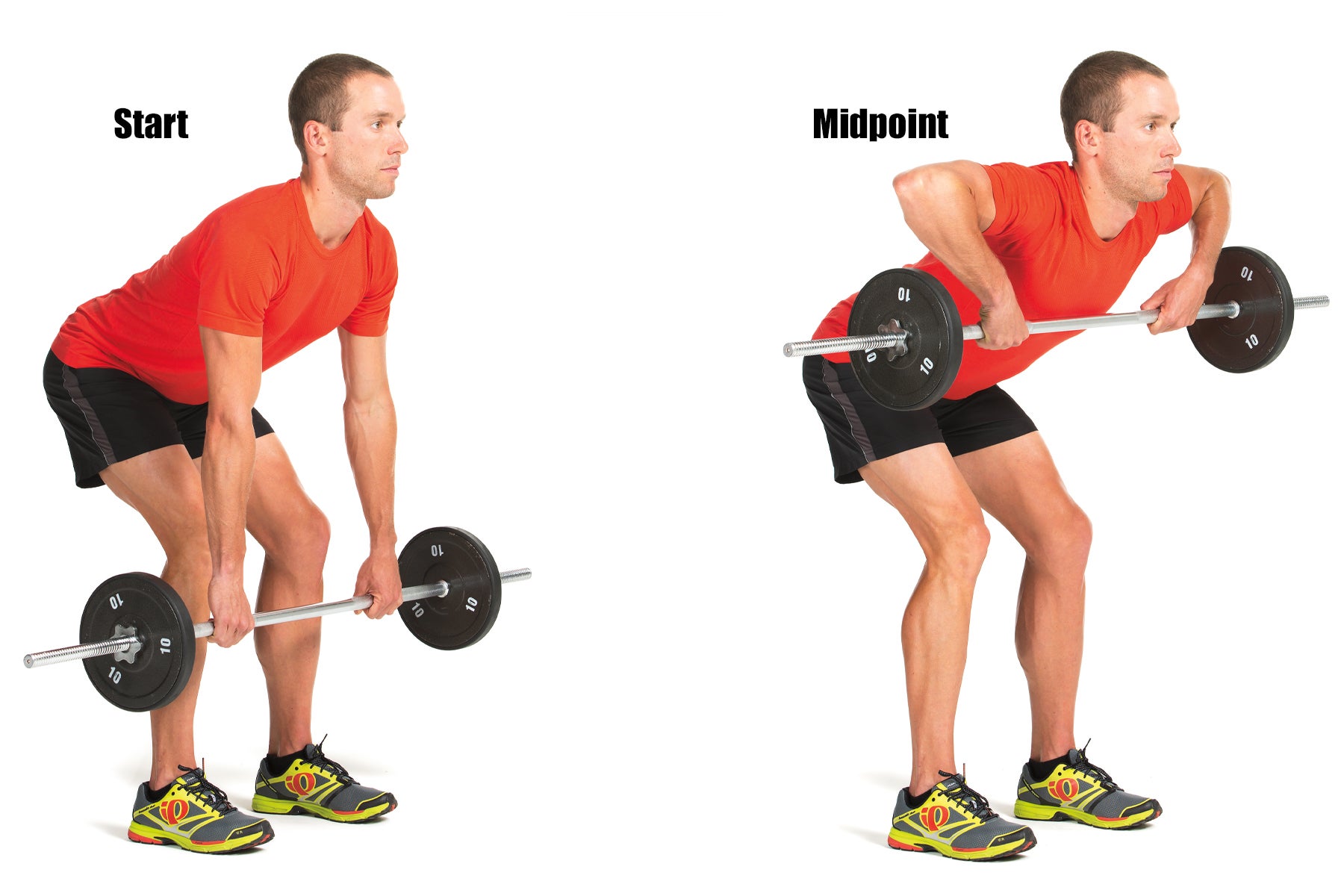
Photo: Jeff Nelson
The barbell row works the biceps, delts, and lats to move the barbell, but it also engages the erector spinae in the lower back to keep you stable in a bent-over position. This strengthens the lower back, which is what keeps you upright and not hunched over during a run.
Hold on to a barbell with a shoulder-width, overhand grip (palms facing your body). Bend your knees slightly, and bend forward at the waist about 45 to 60 degrees while keeping your back straight (see start). Relax your arms and let the weight hang straight down.
While holding this position and keeping your back straight, use just your arms to pull the bar up toward the bottom of your ribs (see midpoint). Try to get the bar to touch your lower chest. Slowly lower the bar back down until your arms are straight. Pay close attention to your lower back during this exercise and keep it as straight as possible—slouching or rounding it can cause injury. Also take care to pull the weight up slowly; do not jerk it up. The rest of your body should be stationary as you repeat the movement to finish your set.
Section dividerDumbbell French Curl
Muscle Focus: triceps

Photo: Jeff Nelson
It may not seem like the triceps are working while running because you don’t actively push down on anything; but when you train the biceps, the triceps are stabilizing the elbow joint. Strengthening them helps you maintain a balance in the arm.
Lie on your back on an exercise bench with your feet flat on the floor. Hold a dumbbell in one hand up over your chest and shoulder, parallel to your body, with your arm fully extended. Place your other hand on your arm just below your elbow, using it to steady and support your lifting arm (see start).
Bend your elbow and slowly lower the dumbbell until it is beside your head, about ear level (see midpoint). Your supporting hand should keep your elbow from moving. Use your triceps to straighten your arm, raising the dumbbell back to the starting position. Repeat until your reps are complete. Switch arms and do the same number of reps on the opposite side to complete your set.
Adapted from Strength Training for Triathletes, 2nd edition, by Patrick Hagerman, with permission of VeloPress.